Disclosure: This article contains affiliate links and as an Amazon Associate, we earn from qualifying purchases made through our links.
Well, gramophone vs phonograph is one of the hottest topics in the vinyl world, and yet, I haven’t found anything on the internet that makes understanding these devices easier.
In this article, we will discuss these devices, their origin, and how they differ from each other. But before we discuss the differences, let me take you on a quick trip through our music history.
Well, it all started in 1877 when Thomas Edison built something incredible that became the origin of the whole music industry. Before 1877, it was just a concept and a dream of our ancestors to record their voices and listen to them, but Thomas made it possible by inventing a device known as the phonograph.
As it was the first invention, it had many limitations and room for improvement. After 13 years of the invention, i.e., in the 1890s, a new device was introduced with a new playback medium, which removed most of the limitations of the phonograph and improved the sound quality to a whole new extent.
The new device was known as the gramophone, which was introduced to the world by Emile Berliner. Emile Berliner introduced the lateral-cut flat disc record as a playback medium, which became the origin of the vinyl records that we use today. Well, that was a short trip to history, and trust me, while writing this, I am getting an awesome feeling that I can’t explain to anyone.
Talking about my first interaction with these legendary devices, I had never seen a phonograph in my entire childhood because my dad and grandpa only used a gramophone, and they also never told me about it. But in high school, I visited my friend’s house, and in the basement, I noticed a strange device with a horn and a cylinder, and guess what? That was my first time seeing a phonograph, and I just fell in love with it after learning about it from my friend.
That particular device wasn’t in good condition, so it couldn’t be played, but after that encounter, I started looking for these in nearby stores. Luckily, I found two phonographs in amazing working condition: a 2-minute model and a 4-minute model. The amazing part is that both were manufactured between 1907 and 1910. The price I paid was equivalent to my 2 months’ pocket money, which was a lot for me at the time.
Since then, I have been using phonographs and gramophones, and I know every single thing about them. I have compared their mechanism and sound quality many times in the past, and today, I am sharing key differences between these devices along with my experience using them.
Previously, we have compared these legendary devices with modern-day devices, i.e., gramophone vs record player, phonograph vs record player, and now, we are going to about the difference and share what improvements the gramophone inventor “Emile Berliner” made, which became the reason for its success.
So let’s start.

AT-LP60X-BK with Edifier R1280DB speakers
A beginner-friendly combo to kickstart your vinyl journey — no extra phono preamp or amplifier needed!
- Beginner-friendly
- Complete plug-and-play setup
- Fully automatic turntable
- High-fidelity sound
- Sleek design and easy to use
Gramophone vs Phonograph:
| Phonograph | Gramophone | |
|---|---|---|
| Definition | The first sound recording and playback device that used Edison cylinders is known as a phonograph. | An evolved version of the phonograph that uses flat discs to play sound using mechanical energy is known as a gramophone. |
| Sound Recording & Playback Medium | Tin foil-wrapped metal cylinders, wax-coated cardboard tubes, and all-wax cylinders. | Shellac records |
| Speed (RPM) | About 120 RPM to 160 RPM | Early discs have 60 to 130RPM speed, but in the end, 78RPM is standardized |
| Playback Time | 2 minutes to 4 minutes | The early discs played for 2 to 3(1/2) minutes each side, but after some time, the playback time was increased to 4-5 minutes each side. |
| Works on | Mechanical energy | Mechanical energy |
| Re-usable | Yes | No |
| End users can record sound themselves and listen to the recorded sound | Yes | No |
| Sound Quality | Poor sound quality | Better sound quality |
| Stylus | There are two types of styluses: a cutting stylus is used while recording sound, and a playback stylus is used while listening to the recorded sound. | Only one stylus is used, which is made from thorn, fiber, or steel. |
| Availability | Rarer than a gramophone | Easily available as compared to a phonograph |
| Cost | More expensive | Less expensive |
| Variants | A 2-minute phonograph and a 4-minute phonograph. | Portable models, table models, pedestal models, and external horn models. |
| Inventor by | Thomas Edison in 1877 | Emile Berliner in 1887 |
So, this is the brief difference between a gramophone and a phonograph. Now, let’s dig deeper and learn more about these devices separately.
What is a Phonograph?
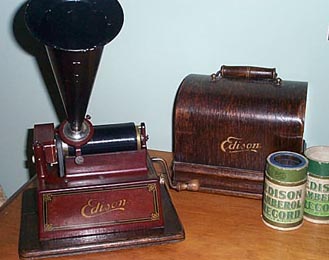
A phonograph is the first device in mankind’s history that made sound recording and playback possible. It was invented by Thomas Edison in 1877. It works purely on mechanical energy, which doesn’t need any sort of speakers or amplifier.
In December 1877, Thomas Edison used an indented sheet of tin foil wrapped around a metal cylinder, which was not a practical recording medium and needed a lot of upgrades.
After the introduction of wax as the recording medium by Alexander Graham Bell and Chichester Bell, Edison replaced the old metal tin-foil cylinder with thicker all-wax cylinders that could be repeatedly used by shaving the current groove surface.
In the current era, we use vinyl records for storing audio, but phonographs used wax cylinders as a sound recording and playback medium. These wax cylinders were reusable by shaving the current groove off the surface, and to reuse the cylinders, the phonograph comes with two styluses: a cutting stylus and a playback stylus.
As the name suggests, the cutting stylus was used to engrave grooves on the wax cylinders, and the playback stylus was used for listening to the recorded sound. One more interesting fact was that the same horn was used to record the sound and listen to it.
Well, the recording and playback concept is similar to modern-day records, i.e., when a person speaks near the horn, it catches sound vibrations which further vibrate the cutting stylus running over the wax cylinders, and grooves are engraved. And, when using a playback stylus, the reverse of the recording concept becomes the playback concept, i.e., the playback stylus runs inside the cylinder’s grooves, which creates vibrations, and we hear sound through the horn.
At the beginning of 1889, the first prerecorded wax cylinder was marketed, and the reusability of cylinders gave it an upper hand over the competitor’s prerecorded gramophone discs, which couldn’t be reused.
But, in the end, it was wax that didn’t last long for a lot of plays. Usually, these soft all-wax cylinders would wear out after 20–25 plays, which is a big challenge to conquer.
In 1902, the Edison team encountered the faster-wearing-out issue by replacing the old soft wax cylinders with improved and hardened wax that could be played 100 times or more. These new and improved cylinders were marketed as “Edison Gold Moulded Records”.
As time passed, a new concept, i.e., a master cylinder, was developed, labeled “Gold Moulded”. Through Gold Moulded, hundreds of cylinders could be made, which boosted production to a whole new level.
Instead of just cylinders, many upgrades were made to the phonograph machine, too. The original phonograph could play just a 2-minute cylinder, but seeing that the gramophone disc’s playback time is around 3-5 minutes, in late 1908, Edison launched new wax cylinders with 4 minutes of playback time along with an upgrade to the phonograph model to support 4 minutes of playback time.
Well, Thomas tried to improve a lot to beat the competition, but in the end, the disc format finally won the commercial battle in the 1910s, and many known record manufacturers dropped the cylinder format and started selling only discs, resulting in the decline of wax cylinders.
How the Phonograph Works:
To learn an in-depth description of the working concept, I recommend reading this article: How does a phonograph work?
Here is a video tutorial showing a glimpse of the working concept:
Different Phonograph cylinders, their RPM, manufacturing material, and pricing:
1) Tinfoil Cylinder
The Tinfoil Cylinder is the first-ever phonograph cylinder, manufactured in 1877. This cylinder has tin foil wrapped around a metal cylinder. It was a 2-minute cylinder that had 60-80 RPM. These cylinders were very fragile and couldn’t be played more than once. On top of that, these couldn’t be removed from the machine without any damage.
2) Beeswax Cylinder
The beeswax cylinder was the successor of tinfoil cylinders, in which Edison used real beeswax instead of tinfoil, which increased its durability and made it easier to record sound. It was also a 2-minute cylinder with 144 RPM.
Both tinfoil and beeswax cylinders were manufactured and used between 1877 and 1901.
3) Brown wax cylinders
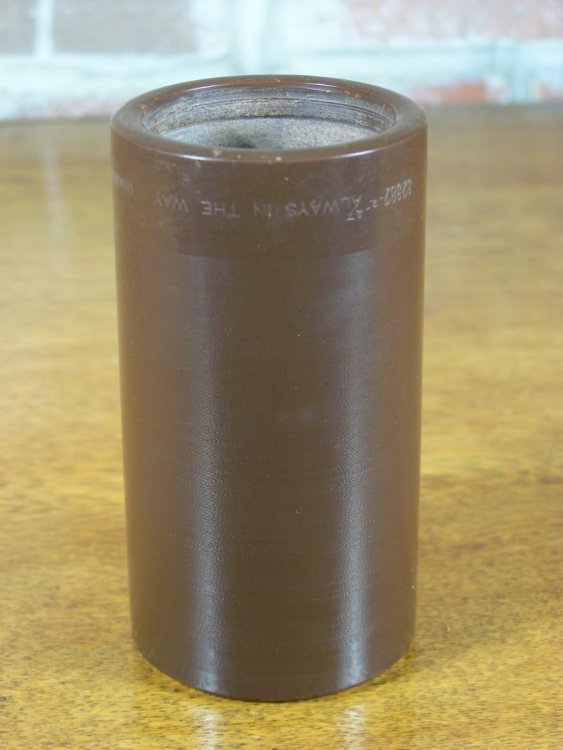
The brown wax cylinder was an improved variant of beeswax in which, instead of beeswax, Edison used natural metallic soap. These are also 2-minute cylinders with 160 RPM.
4) Black wax cylinders
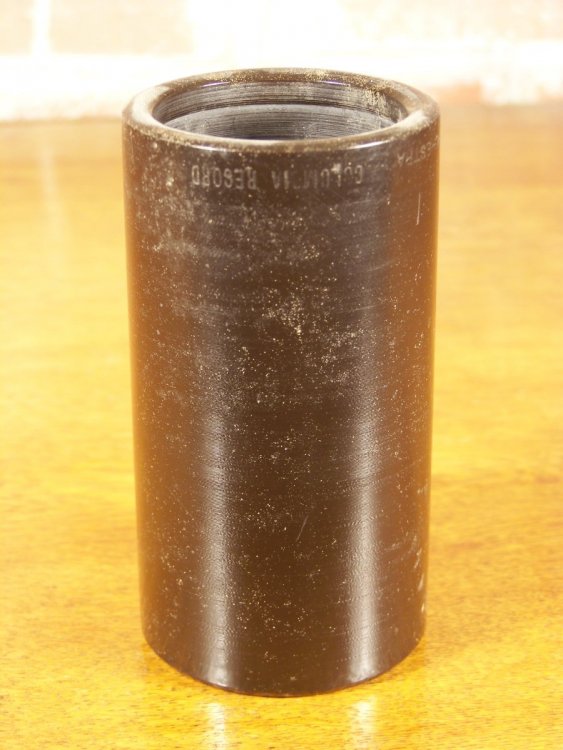
The black wax cylinders further removed the limitation of brown wax cylinders. In brown wax cylinders, Edison used natural metallic soap, but in black wax cylinders, Edison mixed two different materials into metallic soap and made two different types of black wax cylinders:
Gold-Moulded Black Wax:
These are the most popular gold-moulded cylinders, which resolved the cylinder’s wearing-out issue, and after this improvement, the cylinders could be played 100 times or more. In this manufacturing process, Edison mixed carbon black with natural metallic soap, improving durability to a whole new level.
Gold Moulded was used as a stamper, resolving two major problems. Well, with previous cylinders, artists needed to sing their songs again and again to manufacture every single cylinder, but with this cylinder stamper, they only needed to sing for one cylinder, i.e., master cylinders, and after that, the master cylinder was used to manufacture other cylinders.
These cylinders not only saved the artist from the hustle of singing their song again and again but also boosted the manufacturing process to a whole new level.
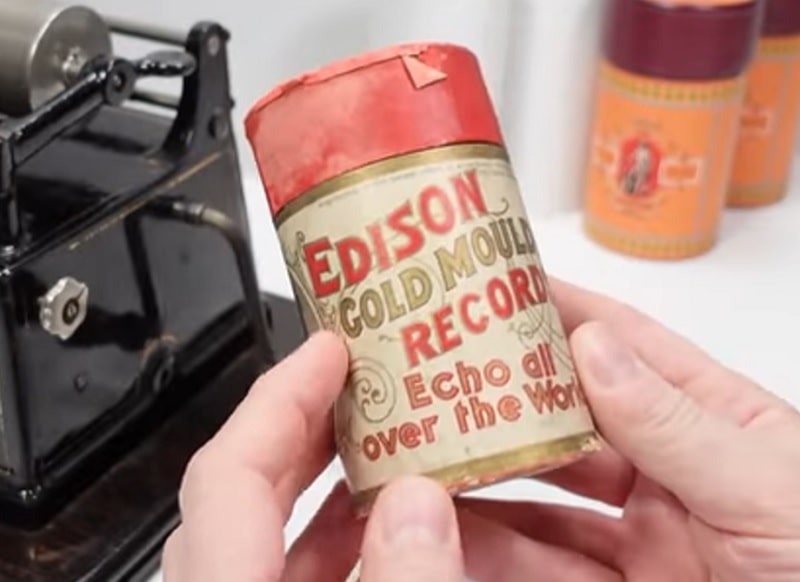
These were also 2-minute cylinders manufactured from 1902-1910 and had 160 RPM.
Metallic Soap Black Wax:
In this cylinder manufacturing process, stearic acid was mixed with natural metallic soap, which made the wax a lot harder and made it durable for more spins on the phonograph. These were 2-minute and 4-minute cylinders manufactured from 1908-1912 and had 160 RPM.
5) Celluloid Cylinders
Edison, the Lambert Company, and Columbia introduced new cylinders manufactured using a synthetic plastic material called celluloid, which also became the origin of these cylinders’ name: “Celluloid cylinders.” These cylinders were harder and more durable than wax cylinders and offered better sound quality and experience.
There are two types of celluloid cylinders:
Blue Amberol or Royal Purple 4-Minute Celluloid cylinders:
Introduced by Edison, these were 2-minute or 4-minute cylinders manufactured between 1912 and 1929 and had 160 RPM.
Indestructible Celluloid Cylinder:
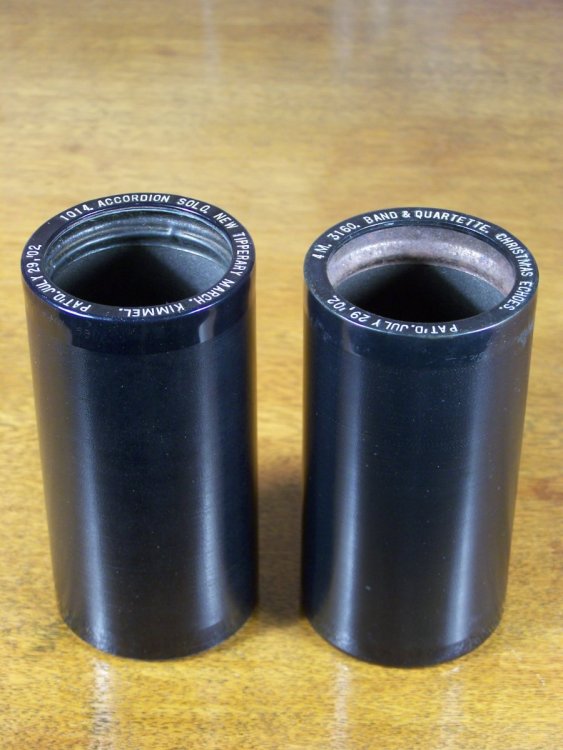
Introduced by Lambert or Columbia, the unique selling point (USP) of these cylinders is that they are nearly unbreakable. These were 2-minute or 4-minute cylinders manufactured between 1900 and 1922 and had 160 RPM.
6) Columbia Twentieth Century Records:
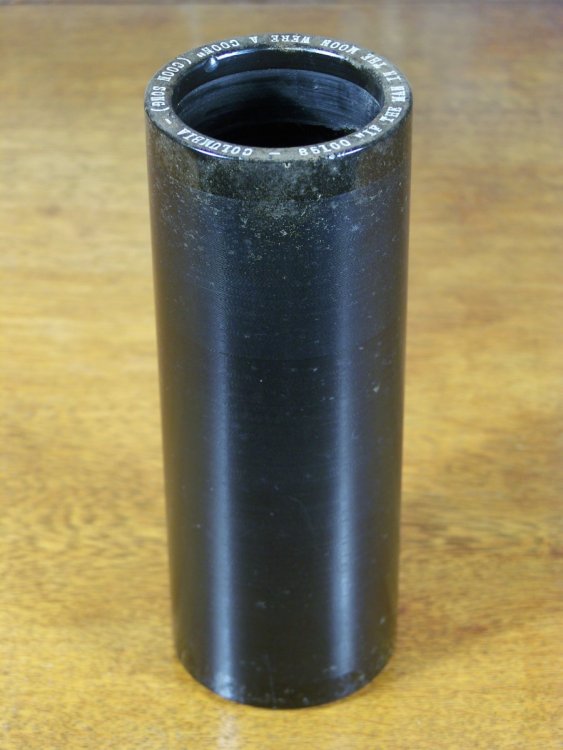
These cylinders have a six-inch length. I don’t have much information about these, but it is worth mentioning. These were launched in 1905 but weren’t able to gain the momentum needed due to the gramophone disc’s popularity.
7) Business Phonograph, Dictaphone, And Spoken Voice Only Dictation Cylinders:
These were 4-inch to 6-inch long records and had 80 RPM.
8) Diamond Disc
From 1912 onwards, Edison also introduced thick diamond discs, which had superior sound quality compared to other records. These records had 80 RPM and remained in the market until 1929.
Price of phonograph records:
The price of phonograph records ranged between $0.50-$0.60 each. The larger cylinders (measuring 4.25 inches long and 5 inches in diameter) used in the Edison Concert Phonograph were sold at $4 each.
After the introduction of Gold-Moulded Hard Black Wax cylinders in mid-1904, stamping was made possible. The company started using Gold Moulded cylinders as a stamper to manufacture wax cylinders in bulk, and boosted the manufacturing process, which further reduced the price of cylinders to $0.35 each.
So, this is all about the phonograph’s history, i.e., its introduction, different cylinders, cylinder pricing, and its decline.
Now, let’s talk about the gramophone and its history.
What is a Gramophone?
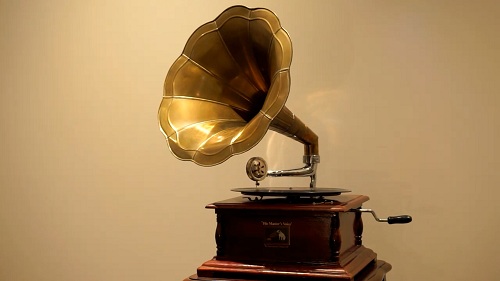
A gramophone is an improved version of the phonograph, which removes the many flaws of the phonograph and becomes the successor of the phonograph in the music industry.
In the 1880s, Alexander Graham Bell’s Volta Laboratory made several improvements to phonographs, like using wax-coated cardboard cylinders and cutting styli. But in the 1890s, Emile Berliner replaced the wax cylinders with flat discs (known as records in modern times).
Just like phonograph cylinders, these initial gramophone discs had a playback time of around 2 minutes with one limitation, i.e., discs are not reusable like Edison cylinders.
At this time, the cylinders had an upper hand due to reusability, and it was not possible to make the disc reusable, either. So, in the end, the limitation of reusability was traded for providing more playback time.
In 1903, Victor introduced the 12-inch 78RPM shellac record that increased the playing time to three and a half minutes.
Seeing the competitor’s increasing playback time move, Edison introduced new 4-minute playback cylinders which required a 4-minute compatible phonograph model. So, you can say that the competition was real and no one wanted to be left behind.
But comparing the wax cylinders with the discs, the gramophone discs had several advantages, i.e., the recording could be done on both sides, the master disk creation was easier as compared to the master cylinder, stamping the shellac material with the master stamper is a lot easier, and bulk manufacturing can be done smoothly, which was the major concern back then because, with the increasing demand, the artist needed to record their music multiple times to fulfill the demand.
These small advantages and advancements received positive feedback from users, which led to the adoption of gramophone discs over Edison cylinders. Due to this adoption, gramophone discs won the commercial battle against wax cylinders in the 1910s.
After that, these discs became the most dominant commercial audio distribution format for the entire 20th century, and the decline of phonographs started right after.
With the advancement in technology, the companies kept improving the disc and replaced the original shellac material with vinyl due to the many advantages that vinyl offers. Along with discs, the gramophone’s design also improved. The design, drive system, pickup system, stylus, sound equalization, and much more all got better over time.
With these continuous improvements, we first got a record player, and after more advancements, we got turntables, which are considered the most superior analog playback medium. We have also compared record player vs turntable, and we suggest you read that article too.
So, this is all about the gramophone’s introduction and how it dominated the music industry for so long. Now, let’s dig deeper and understand the in-depth difference between these two legendary devices.
Difference Between Gramophone and Phonograph:
For a better understanding, we have divided everything into different aspects.
Sound Quality:
Both devices used different groove-tracking techniques.
The phonograph tracks the grooves engraved on the cylinder vertically, whereas the gramophone tracks the shellac record’s grooves horizontally.
The horizontal technique helps the stylus track the grooves better, which results in better sound quality. And, the diaphragm concept in the gramophone is better than the phonograph.
So, in terms of sound quality, the gramophone does sound better than a phonograph.
Playback time:
The playback time of the phonograph is a maximum of 4 minutes using the 4-minute cylinder with a 4-minute compatible phonograph. On the other hand, the early discs of the gramophone had a playback time from 2 minutes to 3(1/2) minutes per side. Later, the playback time is increased to 4-5 minutes per side.
Playback Medium:
In phonographs, wax cylinders were used for recording and playback, while in the gramophone, the flat discs (known as records in modern times) were used for recording and playback.
Re-usability:
The wax cylinders were re-usable, i.e., you could shave off the engraved grooves from the cylinder and re-record anything on it again, but flat discs can’t be reused.
Sound recording by end users:
The phonograph’s wax cylinders allowed the end users to shave off the existing music information from the cylinder, record their own sound, and listen to it, but you couldn’t do the same on the flat disc of the gramophone.
Note: If you are curious to learn how sound is recorded on records and how records output music, then I recommend reading this article- How do vinyl records work., You will find in-depth information covering every recording and playback concept behind vinyl, shellac, and wax cylinders.
Durability:
Both devices are durable and will last longer when you handle them correctly.
Cost:
In terms of cost, it is quite rare to find a perfectly working phonograph that makes it more costly than a gramophone, which is more easily available.
And the 4-minute phonograph model is even rarer, so it could be more costly than the 2-minute model.
Frequently Asked Questions:
Q1- Which came first gramophone or the phonograph?
The phonograph is the first device that made sound recording and playback possible, and it was invented by Thomas Edison in 1877.
The gramophone, invented by Emile Berliner, came after 13 years, i.e., in the 1890s. Well, the gramophone is the evolved version of the phonograph, so yes, the phonograph came first.
Q2- Are gramophone records the same as vinyl?
No, gramophone records are not the same as vinyl records.
The gramophone discs were manufactured with a material called Shellac, whereas vinyl records are manufactured with a material called PVC (Polyvinyl chloride), and the term vinyl also came from the material, i.e., Polyvinyl chloride.
Q3- What made the gramophone better than the phonograph?
These are the improvements that gramophones made, which made a dominant analog music listening medium in the whole 20th century.
1) Sound quality:
Well, the gramophone introduced flat discs that spin horizontally while the wax cylinders of phonographs spin vertically. The horizontal tracking technique helps the stylus to track the grooves more accurately, which results in better sound quality.
2) Playback time:
The playback of the phonograph was limited to 4 minutes, for which you also need a 4-minute phonograph model. On the other hand, the early gramophone discs could be played for about 2 to 3(1/2) minutes on each side, but after some time, the playback time was increased to 4-5 minutes on each side.
3) Playback medium:
The newer playback medium was adopted by the market for many reasons: easier storage, durability, mass production can be done by one stamper, cheaper and easier to manufacture than wax cylinders, and much more.
In the end, no matter how good your product is, the market adoption matters the most. And in between the gramophone and phonograph, the gramophone and its discs became more popular than the phonograph and wax cylinders.
Q4- What are phonograph records called?
The phonograph plays wax cylinders, which are also known as Edison Gold Moulded Records.
Q5- Do gramophones need electricity?
No, gramophones don’t need electricity. They work on mechanical energy.
Q6- Who is the father of the gramophone and phonograph?
Emile Berliner is the father of the gramophone, and Thomas Edison is the father of the phonograph.
Q7- What replaced the gramophone?
At the end of the 20th century, the gramophones were replaced by recorded cassettes, compact discs (CDs), and DVDs, but the successors of the gramophone are the vintage record players.
Q8- Do gramophones still exist?
Yes, the gramophone does exist, and many music/vinyl lovers own it, including me.
Q9- Can a gramophone play modern vinyl records?
No, the gramophone can’t play modern vinyl records. Well, the gramophone needs either a thorn, fiber, or steel stylus to play music, and if you use these styluses on your vinyl records, your records will get a lot of irreversible damage. You can only play shellac records, also known as 78 RPM or SPs.
Also, check out the reel that we have shared on our Instagram and YouTube.
Source:
- Phonograph
- Phonograph record
- Antiquephono
- Information shared by: Tony Kovar (Edison Collector/Restorer – Melbourne, Florida, U.S.A.)
We have shared in-depth insights and the difference between a phonograph and a gramophone. If you have any questions, you can comment below. We will get back to you as soon as possible.



Wonderful explanation. I have one question. From which material are gramophone discs created?
Hi Mc Gehee, In simple words, the gramophone discs are known as shellac records, which are created from shellac material, just like vinyl records are created from vinyl pellets.
Hello! Did both technologies coexist? The phonograph and the gramophone? The Victor Talking Machine Company (founded in 1903) used the gramophone or did it also record its artists on the phonograph?
Yes, both these technologies coexisted. They were both competing with each other at the time, but in the end, the gramophone’s discs were preferred more than phonograph cylinders. In the 1910s, discs won the commercial battle against wax cylinders, and after this, the decline of phonographs started.
Well, one of the founders of the “Victor Talking Machine Company” was Emile Berliner, who was the inventor of the gramophone too, so he used the gramophone to record its artist, not the phonograph.
I have updated the article with deeper insights into these devices and shared information about their competition too. I recommend you reread the article again.
This is probably the best and detailed article I have ever read on phonograph and gramophone. It’s also the the first time I came to know about different types of wax cylinders. I am following you from a very long time and I admit, you have amazing knowledge about turntables and record players. Keep sharing these interesting facts with us. Thanks.
Hi Heymond, Thanks for your kind words. I am really glad to help you out, and yes, I will keep sharing these tips.
Amazing article James! I am totally new to vinyl world and have a very basic question: Does gramophone need speakers to work?
Hi Nick, welcome to our world. How is it going?
Well, gramophone is a mechanical device and it doesn’t need speakers. It outputs music through horn.
Can we play a 2 minute phonograph cylinder on 4 minute phonograph machine?
No, you can’t. The problem is the TPI (threads per inch), or in simple words, groove spacing, and the playback stylus. Even if you try playing, the sound will be bad.
Good morning
What are the criteria for choosing a good gramophone?
What are the brands and models that it is best to choose for an acquisition?
I suggest purchasing a well-maintained old unit or opting for a restored one. The brands you can rely upon are Pathé Gramophones, Columbia Graphophone Co., and Victor Talking Machine Co.